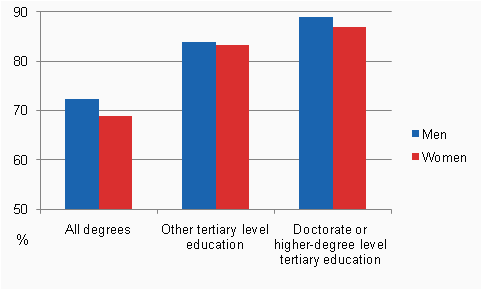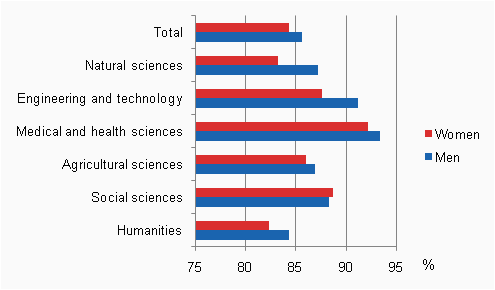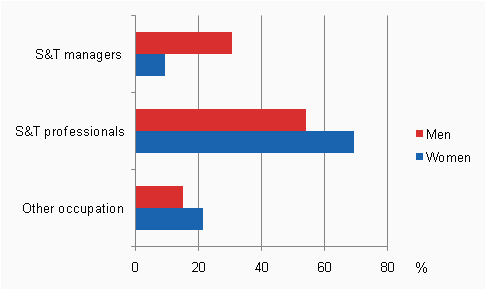This set of statistics has been discontinued.
New data are no longer produced from the statistics.
Published: 24 March 2011
Employment rate exceptionally high among those with tertiary level degrees
In 2008, 85 per cent of those with tertiary level degrees were employed, which is 14 percentage points higher than the employment rate of total population. The situation was best for those with doctorate level degrees, whose employment rate was over 90 per cent. The difference between the employment rate of women and men was small, only good one percentage point, while in total population it was three percentage points.
Employment rates of total population and persons with tertiary level degrees (aged 15 to 65) by level of education and gender in 2008

The employment rate of those with higher university level or doctorate level degrees varies somewhat by field of science. The employment rate was best in the fields of medical and health sciences (93%) and engineering and technology (90%). The employment rates of those with degrees from humanities (83%), natural sciences (85%) and agricultural sciences (86%) were slightly weaker. Differences in employment between men and women were mostly minor, but in the fields of natural sciences and engineering and technology, women's employment was around four percentage points lower than men's corresponding figure.
Employment rate of persons with higher university level or doctorate level degrees (aged 16 to 64) by field of science and gender in 2008

The unemployment rate of those with tertiary level degrees was 4.4 per cent in 2008. The fall in unem-ployment that had continued throughout the 2000s stalled then. At the same time, the unemployment rate of total population was 6.4 per cent. There were also differences between highly educated groups. The unemployment rate of those with doctorate level degrees was lowest, i.e. 2.4 per cent and the unemployment rate of those with lowest level tertiary education was 5.0 per cent.
Sixty-two per cent of the personnel in the field of science and technology worked at specialist tasks and 19 per cent at management. There were great differences between men and women's employ-ment. Nearly one third of men worked at management tasks, while only about every tenth of women. Of men, 54 per cent were employed at specialist tasks and of women 69 per cent. Women's employ-ment at management and specialist tasks has not changed much over the 2000s. Men have slightly increased their share in management tasks.
Occupations of science and technology personnel by occupational group and gender in 2008

Source: Human resources of science and technology 2009. Statistics Finland
Inquiries: Marianne Kaplas (09) 1734 3421, tiede.teknologia@stat.fi
Director in charge: Leena Storgårds
Publication in pdf-format (10 pages 298.9 kB)
- Tables
-
Tables in databases
Pick the data you need into tables, view the data as graphs, or download the data for your use.
Appendix tables
- Appendix table 1. Tertiary degrees by the field of science in 1991, 2000 and 2009 (24.3.2011)
- Appendix table 2. Population with a tertiary degree in 2000 and 2008 (24.3.2011)
- Appendix table 3. Population with a tertiary degree by principal activity in 2008 (24.3.2011)
- Appendix table 4. Employed population with tertiary level education in 2008 by Industry and Tertiary degree (24.3.2011)
- Figures
-
- Appendix figure 1. Doctorate and licentiate degrees in 1993 - 2009 (24.3.2011)
- Appendix figure 2. Doctorate level degrees and the proportion of women 1992 - 2009 (24.3.2011)
- Appendix figure 3. Persons with doctorate degree, median ages by the field of science in 1992 - 2009 (24.3.2011)
- Appendix figure 4. Persons with tertiary degrees as a proportion of the population aged 16 to 74 in 2000 - 2008 (24.3.2011)
- Appendix figure 5. Unemployment rates of persons with doctorate level and higher-degree level tertiary education by the field of science in 2008 (24.3.2011)
- Appendix figure 6. Persons with doctorate level and higher-degree level tertiary education as a percentage by the field of science in 2008 (24.3.2011)
Updated 24.3.2011
Official Statistics of Finland (OSF):
Human resources of science and technology [e-publication].
ISSN=1797-3244. 2009. Helsinki: Statistics Finland [referred: 19.4.2025].
Access method: http://stat.fi/til/tthv/2009/tthv_2009_2011-03-24_tie_001_en.html

